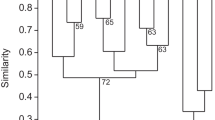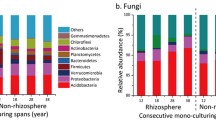Abstract
To elucidate how soft rot disease affects soil characteristics and root-associated, culturable microorganisms in Amorphophallus konjac stands, the responses of soil around roots of A. konjac with soft rot disease were investigated in stands with and without soft rot. Changes in the root-associated culturable microbial community and diversity were investigated by dilution plating. Soil characteristics were compared between stands using standard techniques. A. konjac with soft rot had higher concentrations of available soil P and K, NH4–N, organic matter and water content and lower pH compared with plants without. The community composition of root-associated culturable microorganisms differed between stands with and without soft rot. The microbial community associated with soft rot in A. konjac was characterized by four types of abundant microorganisms (Fusarium solani, Fusarium oxysporum, Pseudomonas chlororaphis subsp. aureofaciens and Stenotrophomonas pavanii) and three types of less-abundant microorganisms (Rhizobium radiobacter, Bacillus thuringiensis and Streptomyces cellulosae), and a small number of Bacillus and Streptomyces species in the rhizosphere and rhizoplane soils. Particular microbial combinations were diametrically opposed between plants with and without soft rot. The richness and diversity of root-associated culturable microorganisms were higher in the stand without soft rot than in the stand with soft rot. A. konjac soft rot led to obvious differences in the diversity and community composition of root-associated culturable microorganisms and in soil characteristics.







Similar content being viewed by others
References
April R, Keller D (1990) Mineralogy of the rhizosphere in forest soils of the eastern United States. Biogeochemistry 9:1–18
Berendsen RL, Pieterse CM, Bakker PA (2012) The rhizosphere microbiome and plant health. Trends Plant Sci 17:478–486
Bibb MJ (2013) Understanding and manipulating antibiotic production in actinomycetes. Biochem Soc Trans 41:1355–1364
Bravo A, Likitvivatanavong S, Gill SS, Soberón M (2011) Bacillus thuringiensis: a story of a successful bioinsecticide. Insect Biochem Mol Biol 41:423–431
Cheng H, Qi XH, Yan JF, Yu JC, Liu Q, Liu ZH (2009) Identification of actinomycetes A-10 against Fuvia fulva. J Jilin Agr Univ 31:248–251
Cui M, Li JG, Chen HR, Pan HM, Zhao XX, Xue QH (2014) Experimental study of biocontrol agents and special organic fertilizer on disease resistance of Amorphophallus konjac soft rot and increasing yield. Shaanxi J Agr Sci 60:28–37
Cullen DW, Lees AK (2007) Detection of the nec1 virulence gene and its correlation with pathogenicity in Streptomyces species on potato tubers and in soil using conventional and real-time PCR. J Appl Microbiol 102:1082–1094
Duan JL, Li XJ, Gao JM, Wang DS, Yan Y, Xue QH (2013a) Isolation and identification of endophytic bacteria from root tissues of Salvia miltiorrhiza Bge. and determination of their bioactivities. Ann Microbiol 63:1501–1512
Duan JL, Shu ZM, Wei LZ, Fu LL, Xue QH (2013b) Microecological mechanisms of red-leaf disease occurrence in Salvia miltiorrhiza Bge. Chin J Appl Ecol 24:1991–1999
Gandhimathi R, Arunkumar M, Selvin J, Thangavelu T, Sivaramakrishnan S, Kiran GS, Shanmughapriya S, Natarajaseenivasan K (2008) Antimicrobial potential of sponge associated marine actinomycetes. J Med Mycol 18:16–22
Gardner JM, Chandler JL, Feldman AW (1984) Growth promotion and inhibition by antibiotic-producing fluorescent pseudomonads on citrus roots. Plant Soil 77:103–113
Gordon RE, Haynes WC, Pang CHN (1973) The genus Bacillus. Agriculture Handbook No. 427. US Dept Agric, Washington DC
He F, Zhang ZL, Cui M, Xue QH (2015a) Effect of biocontrol actinomycetes agents on microflora in the root-zone of Amorphophallus konjac K.Koch ex N.E.Br. Chin J Appl Environ Biol 21:1–7
He F, Zhang ZL, Cui M, Xue QH, Wang DS (2015b) Disease prevention and growth promotion effects of actinomycete strain D74 on Amorphophallus konjac. Acta Hortic Sin 42:367–376
Jain PK, Jain PC (2007) Isolation, characterization and antifungal activity of Streptomyces sampsonii GS 1322. Indian J Exp Biol 45:203–206
Kloepper JW, Ryu CM, Zhang S (2004) Induced systemic resistance and promotion of plant growth by Bacillus spp. Phytopathology 94:1259–1266
Kwon JH, Choi O, Kim J (2013) Fusarium oxysporum causing wilt and stem rot in Chrysanthemum × morifolium in Korea. Plant Dis 97:1118
Li T, Wei WG, Shao W, Chen BL, Huang YP (2010) Lead and other elemental content of normal and Erwinia carotovora infected Amorphallus konjac corms. Bull Environ Contam Toxicol 84:744–748
Li Y, Chi LD, Mao LG, Yan DD, Wu ZF, Ma TT, Guo MX, Wang QX, Quyang CB, Cao AC (2014) First report of ginger rhizome rot caused by Fusarium oxysporum in China. Plant Dis 98:282
Lin X, Cao L, Xiong J, Zhang R (2012) Interactions of denitrifying bacteria, actinomycetes, and fungi on nitrate removal in mix-culturing systems. Water Air Soil Pollut 223:2995–3007
Meng Q, Yin J, Rosenzweig N, Douches D, Hao JJ (2012) Culture-based assessment of microbial communities in soil suppressive to potato common scab. Plant Dis 96:712–717
Miao L, Dong XW, Zhou XJ, Ding BT, Liu Y, Zha XY, Dong KM (2011) Isolation and identification of biocontrol fungi against tobacco bacterial wilt and their antagonistic activity. J Henan Agri Sci 40:81–85
Milanowski J, Dutkiewicz J, Potoczna H, Kus L, Urbanowicz B (1998) Allergic alveolitis among agricultural workers in eastern Poland: a study of twenty cases. Ann Agric Environ Med 5:31–43
Moussa LA, Mohy EA, El Banna IM (2012) Zea mays cultivar behavior as affected by Rhizobium radiobacter inoculation in salt-stressed environments. J Am Sci 8:743–750
Nelson DW, Sommers LE (1982) Total carbon, organic carbon and organic matter. In: Page AL (ed) Methods of soil analysis, part 2, Chemical and microbiological properties. American Society of Agronomy and Soil Science Society of America, Madison, WI, pp 539–579
Nishimori E, Kita-Tsukamoto K, Wakabayashi H (2000) Pseudomonas plecoglossicida sp. nov., the causative agent of bacterial haemorrhagic ascites of ayu. Plecoglossus altivelis. Int J Syst Evol Microbiol 50:83–89
Ongena M, Jacques P (2008) Bacillus lipopeptides: versatile weapons for plant disease biocontrol. Trends Microbiol 16:115–125
Oyedele DJ, Gasu MB, Awotoye OO (2008) Changes in soil properties and plant uptake of heavy metals on selected municipal waste dump sites in Ile-Ife, Nigeria. Afr. J Environ Sci Technol 3:106–115
Padmaja K, Lakshmi V, Sreekanth Y, Gopinath R (2012) Nebulizer induced superinfection and sepsis with Chryseobacterium indologenes in a postoperative patient with Acinetobacter baumannii pneumonia: a case report and review. Int J Infect Control 8:1–4
Page AL (1982) Chemical and microbiological properties. In: Page AL (ed) Methods of soil analysis, part 2, Chemical and microbiological properties. American Society of Agronomy and Soil Science Society of America, Madison, WI, pp 625–641
Peech M (1965) Hydrogen-ion activity. In: Black CA (ed) Methods of soil analysis, part 1, Physical and mineralogical properties. American Society of Agronomy, Madison, WI, pp 914–926
Raave H, Keres I, Kauer K, Nõges M, Rebane J, Tampere M, Loit E (2014) The impact of activated carbon on NO3 ––N, NH4 +–N, P and K leaching in relation to fertilizer use. Eur J Soil Sci 65:120–127
Ruotsalainen AL, Eskelinen A (2011) Root fungal symbionts interact with mammalian herbivory, soil nutrient availability and specific habitat conditions. Oecologia 166:807–817
Saini J, Saluja M, Chhuneja P, Kaur S (2014) Rapid isolation of genomic DNA from Blumeria graminis f. sp. tritici, the cause of wheat powdery mildew, using CTAB method. J Res 51:150–153
Shannon CE, Weaver W (eds) (1949) The mathematical theory of communication. University of Illinois Press, Urbana, IL
Shen GH (2012) Studies on mechanism of strawberry replant root rot disease and alleviation with biological and chemical methods. PhD dissertation, Northwest A&F University, Yangling, China
Tamura K, Peterson D, Peterson N, Stecher G, Nei M, Kumar S (2011) MEGA5: molecular evolutionary genetics analysis using maximum likelihood, evolutionary distance, and maximum parsimony methods. Mol Biol Evol 28:2731–2739
Vasques CA, Rossetto S, Halmenschlager G, Linden R, Heckler E, Fernandez MS, Alonso JL (2008) Evaluation of the pharmacotherapeutic efficacy of Garcinia cambogia plus Amorphophallus konjac for the treatment of obesity. Phytother Res 22:1135–1140
Wang RY, Gao B, Li XH, Ma J, Chen SL (2014) First report of Fusarium solani causing Fusarium root rot and stem canker on storage roots of sweet potato in China. Plant Dis 98:160
Wu J, Diao Y, Gu Y, Hu Z (2010) Infection pathways of soft rot pathogens on Amorphophallus konjac. Afr. J Microbiol Res 4:1495–1499
Wu J, Diao Y, Gu Y, Hu Z (2011) Molecular detection of Pectobacterium species causing soft rot of Amorphophallus konjac. World J Microbiol Biotechnol 27:613–618
Wu J, Liu X, Diao Y, Ding Z, Hu Z (2012) Authentication and characterization of a candidate antagonistic bacterium against soft rot of Amorphophallus konjac. Crop Prot 34:83–87
Xue L, Xue Q, Chen Q, Lin C, Shen G, Zhao J (2013) Isolation and evaluation of rhizosphere actinomycetes with potential application for biocontrol of Verticillium wilt of cotton. Crop Prot 43:231–240
Yang J, Ruegger PM, Mckenry MV, Becker JO, Borneman J (2012) Correlations between root-associated microorganisms and peach replant disease symptoms in a California soil. PLOS One 7:e46420
Yu L, Nicolaisen M, Larsen J, Ravnskov S (2012) Succession of root-associated fungi in Pisum sativum during a plant growth cycle as examined by 454 pyrosequencing. Plant Soil 358:225–233
Zhang ZL, Liu LP, He F (2014) Study of combined application of actinomycetes biocontrol agents and potassium humate on disease resistance and growth-promoting effect of Amorphophallus konjac. Humic Acid 4:45–49
Zhou Y, Choi YL, Sun M, Yu Z (2008) Novel roles of Bacillus thuringiensis to control plant diseases. Appl Microbiol Biotechnol 80:563–572
Acknowledgements
The authors are grateful to Dr. Chaofeng Lin for insightful comments and suggestions on the manuscript. This study was financially supported by the Key Sci-tech Promotion Project of State Forestry Administration, China (2010-38), the Agriculture Sci-tech System Construction Project of Ministry of Finance, China (XTG2013-36), and the Sci-tech Research Development Program of Shaanxi Province, China (2013K02-24).
Author information
Authors and Affiliations
Corresponding author
Ethics declarations
Ethics statement
The experiments comply with the current laws in China.
Conflict of interest
The authors declare that they have no conflict of interest, and they do not have a financial relationship with the organization that sponsored the research.
Rights and permissions
About this article
Cite this article
He, F., Zhang, Z., Cui, M. et al. Soft rot disease alters soil characteristics and root-associated, culturable microbial community of Amorphophallus konjac . J Gen Plant Pathol 84, 44–57 (2018). https://doi.org/10.1007/s10327-017-0759-y
Received:
Accepted:
Published:
Issue Date:
DOI: https://doi.org/10.1007/s10327-017-0759-y




